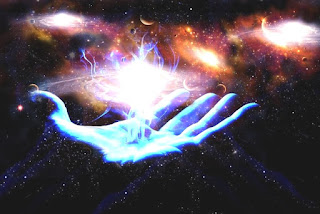Beautiful myths about the creation of the Universe, from different cultures
Hindu Myth:
Brahma emerged from the void. With the power of thought alone, he created the waters in which he deposited his semen. Which turned into a golden egg, from which he was born.
Again by thought, Brahma divided the egg into two, and the halves became heaven and earth. Brahma grew alone and divided into two to form man and woman. In a variant of the legend, Brahma repeatedly splits himself in two until all living beings in the world are created from his body. In another version, the first man and woman reproduce in different animal forms until all life forms are created.
Together, Brahma (the Creator), Vishnu (the Preserver) and Shiva (the Destroyer) make up the Supreme. Every universe that Brahma creates is destroyed by Shiva, after which there is nothing but a vast ocean in which Vishnu floats, supported by a great snake. In some versions of the myth, Brahma does not emerge from an egg, but from a lotus flower that sprouts from Vishnu's navel.
Eventually, our world will also be destroyed by Shiva, restarting the cycle.
Interestingly, in Egyptian mythology, there are also references to primordial waters in the universe, symbolized by the goddess Nun. In Sumerian mythology, Tiamat represents chaos and primordial waters. A further parallel can be seen in Chinese mythology, where a cosmic egg also gave rise to heaven and earth.
Chinese Myth:
The first living being, P'an Ku, grew over 18 thousand years inside a cosmic egg. When it finally hatched, the shell above it formed the sky, while the shell below became the earth. Natural opposites were separated, such as male and female, wet and dry, light and dark, yin and yang, among others. After this monumental process, P'an Ku literally fell apart, and its features gave rise to the natural world.
His limbs became mountains, his blood became rivers, his breath became wind, his voice became thunder, his hair became grass, his sweat became rain, and so on. His left eye became the sun and his right eye became the moon.
Navajo tribe myth
The Navajo Native American tribe has one of the longest and most complex creation stories in the world. It starts in the first world, called the Black World. This world contained four clouds, including a black one, representing the female substance, and a white one, representing the male sex.
Uniting, they gave rise to the First Man, representing dawn and life, and the First Woman, symbolizing darkness and death. Other beings in the Black World included the Great Coyote (who was conceived from an egg), the First Brave, and various insects.
The Black World became very populated, however, so everyone went up to the Blue World of birds. There, they lived in harmony for 23 days, until someone tried to sleep with Chief Andorinha's wife.
Exiled to the Yellow World of mammals, they found six mountains where sacred people resided.
These holy people were immortal, traveling through the rainbow. In that place, the First Woman gave birth to two hermaphrodites. Four days later, she gave birth to another set of twins, a male and a female. At the end of 20 days, five pairs of twins had been born. One day, Big Coyote stole the Water Monster's baby, enraging him to the point of unleashing a rain that turned the waters into a flood that overcame the mountains.
In what must have been the slowest flood ever, the First Man planted several trees and a cane field in succession, none of which grew above the water level. Finally, a sugar cane field reached the heavens. People climbed that elevation and found the fourth world, the White World, which is the world we all inhabit today.
Interestingly, in Sumerian mythology, in the Enuma Elish myth, they also mention a flood, and it is notable that the biblical narrative of the Christian flood is only recorded thousands of years later.
Egyptian Myth:
Egyptian religion is very complex due to the existence of more than 2000 gods (we only know the main ten or twelve, and the names they gave them to the Greeks). Furthermore, the complexity is accentuated by the presence of different myths depending on the region of Egypt.
Different myths attribute creation to different gods: the group of eight primordial gods was called Ógdoad. Also depending on the region, different trinities were worshiped.
I will mention the best known: Osiris (father), Isis (mother) and their son Horus.
First there was a primordial ocean, in the cosmos, it was Nun.
The beginning of the cosmos was marked by a primordial ocean called Nun. From this ocean arose a mountain that gave rise to the divinity Atum, often appearing as Ra. Atum is considered one of the aspects of the sun god Ra, and is occasionally referred to as Atum-Ra.
Ra, the Egyptian sun god, gave rise to the first gods emanating from his own essence. Thus, Shu, god of aridity and air, and his consort Tefnut, goddess of humidity, emerged, together forming the atmosphere. This divine pair, in turn, gave rise to other gods fundamental to the complete formation of the cosmos: Geb, the god of Earth, and Nut, the goddess of Heaven, culminating in the formation of the world.
Then, Earth and Heaven generated the Principles of Life, composed of the gods Osiris, the perfect being who would eventually rule the rest of the world, Isis (mother of all pharaohs), Set (god of storms, chaos and war ) and Nephthys (commonly represented as the lady of the home and protector of the dead).
As for the origin of humanity, as narrated by myth, human beings emerged from the tears of Ra, thus populating the world. It is worth mentioning that other myths attribute creation to different gods, such as Ptah or the god Khnum.
Dogon Myth:
The Dogon people are an indigenous tribe living in Mali, believed to be descended from the Egyptians. The Dogon became known for sharing legends about the constellation Orion and the star Sirius (when telescopes didn't even exist yet).
Their origin stories begin with Amma, the god who existed before time. Amma was alone, so he created the Earth, sometimes called “world egg” or “original placenta”. The Earth exists in infinite space and contains a blueprint for all creation. Amma married Terra, who later gave birth to Ogo and a pair of androgynous fish-shaped twins named Nommo.
Ogo, not having a partner or twin, committed incest with Earth, resulting in the first menstrual blood and the manifestation of the spirits of the underworld. Amma, to correct the imbalances caused by this act, transformed Ogo into a jackal. The blood that flowed from the Earth transformed into various celestial entities, plants and animals.
Amma then created the stars by throwing pieces of earth into space. Using two clay bowls, one with red copper and the other with white copper, he formed the sun and the moon.
It is said that black humans were born in sunlight, while white humans were born in moonlight.
I must point out that the Nommo are equivalent to the Anunnaki beings described by the Sumerians or the Neteru gods mentioned by the Egyptians.
The god Amma was possibly inspired by the name of the Egyptian god Ammon.
Sílvio Guerrinha




















